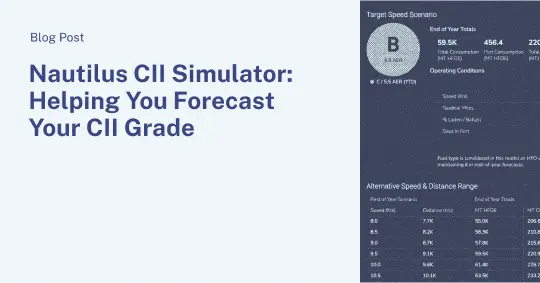Dead Reckoning helps correcting defective Position Data
Understanding a ship’s actual position and route is fundamental to successful maritime operations, and managing a vessel from shore with erroneous position data can cost shipping companies real dollars. Unfortunately, AIS is frequently unreliable, and at Nautilus Labs, we have seen that that even sensor-direct GPS data can be deficient depending sensor integrity and the ship in question. Position error can further be introduced throughout the data collection, retrieval, and storage process.
We aim for our clients to trust all the data we display to ensure confidence in the insights our platform provides. To do this for position data, we implement proprietary techniques like Dead Reckoning to detect, measure, and, if possible, correct for this kind of systematic error – helping our clients answer the elemental question of where a vessel actually was at any point in time. By combining accurate ship position data with weather data, owner-operators can take concrete actions to optimize voyage economics in real-time.
Types of Position Data Anomalies
No physical sensor is free of error and noise, including onboard GPS receivers. Several on-ship subsystems can sit between a GPS receiver and a data logger, and they can introduce error and noise along the way. At Nautilus Labs, we’ve collected hundreds of thousands of hours of GPS data and have observed many different kinds of anomalies. Sometimes independent latitude and longitude values can update at different frequencies. At other times, the GPS sensor interface does not indicate null values – so when the GPS source is powered off, zero values are not easily distinguishable from no data. Sensor data collection and storage can also introduce error by not treating GPS data as a circular value in the 360-degree system when performing calculations. This causes anomalies when a ship crosses the 180-degree meridian – sometimes the ship will briefly appear on the opposite side of the Earth, at the prime meridian.
In many cases, the statistical impact of sensor noise can be handled with basic smoothing and aggregation. However, when it comes to certain kinds of data, even a small amount of noise can introduce a significant amount of visual disturbance for a ship shown on a map. And all too often, we see clients dealing with low resolution, low-frequency GPS data that also has noise. A fundamental question that our clients ask is, “Where is my ship?”
The Nautilus Labs Solution
When designing new systems, several practices can help mitigate these issues. Sensor collection systems should be able to distinguish an absent GPS value from a present GPS value. Structured data collection could also support the use of unambiguous coordinate systems (like n-vector geodesy, that avoid the pitfalls of the ambiguous 360-degree system). Collection of sensor metadata could allow for the monitoring of the health and status of a physical sensor. Nautilus Labs strives for this kind of excellence and is always raising the bar in terms of standards. However, at the same time, we recognize that in order to deliver valuable solutions quickly to our clients, we can’t go fixing every sensor-related issue at once. To provide the best experience, we must adapt to handle the downsides of current systems, and we use software to do it.
Dead Reckoning
So how can we solve this kind of systematic GPS error? One way is to leverage Dead Reckoning and Sensor Fusion. In a vacuum, a GPS receiver is extremely difficult to correct, but in the presence of a rich array of sensor values – including reliable weather data, ship heading and speed, previous position, and noon data points, we can create dynamic models of a ship’s movement in the ocean independent of GPS data.
Dead Reckoning is one of the oldest forms of maritime navigation. Before onboard GPS and ECDIS systems, captains leveraged dead reckoning to track their course. By using a known starting position, and the duration spent at different speeds and headings, an approximation of current position can be calculated. The resulting “projected” position can then serve as input to calculate the proceeding projected position. Of course, this technique is susceptible to accumulated error – the larger the difference in time between the known starting position and the current estimated position, the more error incurred and the greater the deviation from the true course. The model can be improved by introducing other external factors such as wind and current speed into distance calculations, but accumulated error will always be present. Part of the reason systems like GPS are so popular is because they are immune to accumulated error. However, as described above, GPS data collection has its own issues.
Sensor Fusion comes into play by allowing us to combine the empirical dead reckoning technique with the high accuracy GPS data sources like sensor data and noon reported values. By selectively incorporating a known position as an input to a Dead Reckoning model, accumulated errors can be bounded and made close to negligible. In turn, the dead reckoned values can accurately fill in detail of low frequency or erroneous GPS data. This is one of the big value propositions of comprehensive high-frequency data collection: by painting a complete picture of a ship and its environment, the accuracy and sophistication of insights can be improved.
The Future with Nautilus Labs
While answering the question, “Where is my ship?” is important, it’s only the start of the kinds of problems that can be solved by combining integrated high-frequency data, noon, and third party weather collection with sensor fusion. Here at Nautilus Labs, we see incredible value in bringing these same techniques to applications beyond GPS – enabling a class of retrofitted vessels to operate competitively in a rapidly changing maritime industry.


